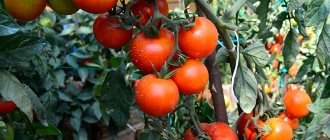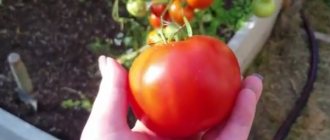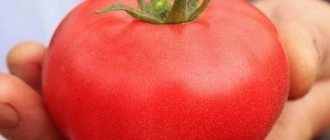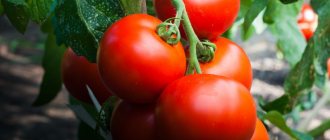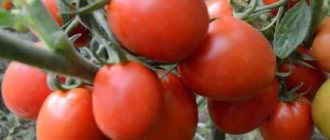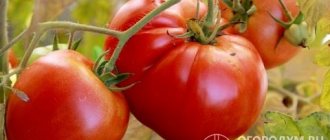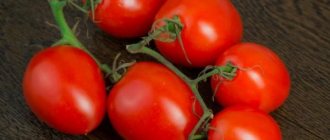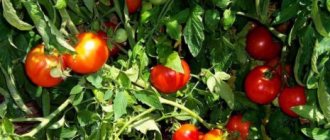Banana legs in the photo by Evgeniy Balashov
Recently, the Banana Legs tomato variety has become more popular than any other. It owes its popularity mainly to Tatyana’s video, the author of the Harvest Vegetable Garden channel. Indeed, on her plot she managed to grow tomatoes that captured the imagination of many residents of the middle zone. After all, such tomato harvests are very rare in our country. And indeed, many wanted to experiment with this variety in their growing climatic conditions - what if it also turns out like Tatyana’s in the video, the same bushes, completely covered with clusters of yellow elongated tomatoes.
And now more about this certainly interesting variety. Well, after the article - reviews from gardeners and gardeners from different regions about the Banana Legs tomato and there - all the pros and cons of the variety. By the way, in 2022 the variety is included in the State Register of the Russian Federation for cultivation in film greenhouses in private household plots.
Characteristics and description of the variety
Tomatoes Banana legs are medium-sized and belong to the semi-determinate type. The height of the bush does not exceed 70-80 cm in open ground and 1-1.5 m in a greenhouse.
The leaves and stems of the variety are thin, so you can plant two tomato bushes in one hole.
After 9-11 leaves, the first inflorescence is formed on the stem. The next ones are laid every 2-3 sheets.
The first harvest at the stage of technical ripeness can be harvested 90-95 days after emergence.
When fruits are fully biologically ripe, they acquire a bright orange color with yellow stripes and barely noticeable splashes of pink.
The skin of the Banana Legs variety is dense, so the tomatoes are not prone to cracking.
The fruits have an elongated shape with a tuberculate surface and a pointed nose pulled to the side. The average weight of one tomato is 80 g.
The pulp has two seed chambers with a small number of seeds. When not fully ripened, the photo shows that the inside of the tomato has a central white vein.
The State Register commission noted the taste of the tomato as good. But, like most early varieties, Banana Legs does not have a pronounced tomato aroma. The taste has a characteristic sourness, the flesh is quite dense.
Tomatoes are ideal for pickling for the winter and for making fresh salads.
The variety's seeds are produced for sale by the agricultural company Partner.
Video
You can also watch a video where they will show you the Banana Legs variety and tell you about the advantages of choosing this variety.
Despite the fact that the taste of the tomato, the “Banana Legs” variety, is considered to be somewhat exotic (tomatoes with a citrus flavor, after all), we see that ideas about the species are only positive. For this reason, if you are interested in these unusual tomatoes, we advise you to grow a number of bushes on your own summer cottage in order to understand whether the “Banana Legs” variety is suitable for you personally.
When to plant seedlings
Tomato seeds Banana legs are sown for seedlings 45-50 days before transplanting to a permanent growing location. To this period add 3-5 days, which will be needed for germination of planting material.
Sowing time largely depends on the region and growing conditions in which the crop will be kept.
In the south, seeds for seedlings can be planted in early March. For residents of the northern regions, planting dates are shifted to the end of March or beginning of April.
Planting seeds and growing seedlings
The variety can be grown without seedlings. But a richer harvest and stronger bushes will only be achieved when growing seedlings at home.
Sow Banana Legs seeds according to the standard pattern for tomatoes. When sowing in common containers, the distance between the grains should be 1.5-2 cm. The planting material is buried approximately 1-2 cm.
The optimal temperature for the appearance of the first shoots is from +23 to +25 degrees. After pipping, the temperature is reduced. This will prevent the risk of seedlings being pulled.
When planting early, additional illumination of seedlings will be required. In the absence of sufficient light, the seedlings will become elongated, thin, frail and long.
After the formation of the first pair of true leaves (not to be confused with cotyledons), the tomatoes are planted in separate cups.
2 weeks after transplantation, the seedlings are fed for the first time. For these purposes, special fertilizers for tomato seedlings with a predominance of nitrogen are used.
Two weeks before transplanting to a permanent place, banana legs tomatoes begin to harden in the fresh air, veranda or in a greenhouse.
Preparation of planting material and propagation
The Banana legs tomato (variety description, photo can be found in the article) is grown in 2 ways: seedlings and non-seedlings. To get the maximum yield, you need to study all the rules of growing each of these methods.
The first step in growing banana legs tomatoes is preparing planting material. Proper preparation will not only prevent the occurrence of plant diseases in the future and will significantly increase the percentage of seed germination.
Before planting, you should check the quality of the seeds. Look at the expiration date, sort through the seeds, removing spoiled and darkened ones. To make sure that the seeds will sprout, you should soak them in a salt solution - 1 tbsp. 1 tsp. salt. After 30 min. you should check - the seeds that have sunk to the bottom will definitely sprout.
It is important to properly disinfect planting material. This stage will help minimize the risk of plant infection. Many gardeners disinfect seeds in potassium permanganate. To prepare the working solution, you need to take 1 tsp. potassium permanganate and dilute in 10 liters of water.
There are other means for high-quality seed disinfection:
- Fitosporin. You need to take ½ tbsp. water and dilute ½ tsp in it. facilities. Soak the seeds, the time indicated on the packaging of the product.
- Soda. In 1 tbsp. dilute water with 1/tsp. soda Leave the seeds in the soda solution for 12 hours.
- Aloe juice. Mix aloe juice and water in equal proportions. Soak the seeds in the resulting solution for a day.
If disinfection was carried out with potassium permanganate, then the planting material should be additionally treated with a growth stimulator, for example, Epinom is suitable for these purposes.
Features of growing in open ground and greenhouses
Banana legs are moved to open ground or a greenhouse after the ground has warmed up to +10 degrees and the air temperature is not lower than +12.
For 1 sq. m. place up to 3 plants. Form into 2-3 stems. With dense planting (up to 5 bushes per sq. m.), the crop can be planted in one trunk.
To obtain an earlier and richer harvest, it is recommended to remove all stepsons up to the first flower cluster.
The watering and fertilizing requirements for the Banana Legs tomato variety are standard, as for other types of tomatoes. To reduce the frequency of watering, tomato beds are mulched.
It should be taken into account that the crop is prone to blossom end rot due to the structural features of the fruit. The disease is the scourge of most elongated tomatoes.
Calcium nitrate against blossom end rot is considered one of the best remedies. The drug is applied to the holes before planting the bushes, used as a top dressing during watering, or the bushes are treated leaf by leaf.
Like all tall tomatoes, Banana Legs need extra support. Moreover, you will have to tie up not only the central stem, but also the side shoots.
Features of care
As the stem grows, you will need to select the three strongest branches and form a bush, and remove all the rest. This is the only way to increase productivity. If pinching is not carried out, there will be lush greenery, but the fruits will be small and there will be few of them.
Another requirement for obtaining powerful tomatoes is garter. Too large and heavy fruits can lead to stem breakage.
Tomatoes should be watered as needed. Otherwise he is unpretentious. And this is another advantage of the variety.
Disease resistance
Banana feet are susceptible to blossom end rot. Preventive treatments and fertilizing with calcium nitrate will help avoid fruit spoilage.
In reviews, gardeners note that the variety is not very resistant to fungal diseases. In open ground, a tomato can have time to get rid of late blight, but when grown in a greenhouse, it sometimes becomes infected with cladosporiosis.
To prevent disease, tomato bushes are treated with fungicides.
Like other tomatoes, Banana Legs are not immune to pest attacks. At the first signs of aphids and whiteflies, the bushes are treated with insecticides. When tomatoes are attacked by spider mites, the plants are sprayed with insectoacaricides.
Reviews from gardeners about banana legs tomatoes
I grew Banana Legs last year. ... I really liked the variety! I grew it into two stems, then I read that it doesn’t need to be pinched. I stopped removing the stepchildren and this immediately affected the yield. Therefore, I concluded that this variety has moderate pinching, i.e. you can leave two, three, four stems. But you can’t let it go completely to chance; it instantly grows leaves, the tomato becomes smaller and they become smaller.
Irina
https://www.tomat-pomidor.com/forums/topic/2642-%D0%B1%D0%B0%D0%BD%D0%B0%D0%BD%D0%BE%D0%B2%D1%8B %D0%B5-%D0%BD%D0%BE%D0%B3%D0%B8-banana-legs/
Seven tomato bushes Banana legs just filled me with tomatoes up to the tomatoes)), we ate them and gave them away. I canned a lot. The taste is excellent! So meaty.
Bazhena
https://otzovik.com/review_5748674.html
The fruit pulp is quite watery and sour, the skin is thick, so the keeping quality is good. Neither end rot nor any other rot was noticed when grown in a shelter, but the bushes planted outside became sick with late blight due to dampness.
Vera Severaya
https://irecommend.ru/content/znamenitye-khvalenye-bananovye-nogi
I will plant banana legs this year, the reviews from forum members are very good, but as they say, the taste and color...
Brunette
https://sib-sad.rf/viewtopic.php?p=26085
Advantages and disadvantages
Like almost any variety of tomatoes, Banana Legs is not without its advantages and disadvantages. The pros and cons are compiled based on reviews from those vegetable growers who planted this cultivar.
pros
Abundant and long-lasting fruiting.
Early ripening.
Beautiful appearance of the fruit.
Not a hybrid - you can collect your own seeds for seedlings.
Low maintenance requirements.
Tomatoes are easily transported without loss of commercial quality.
Good seed germination.
Minuses
Not resistant to fungal diseases (late blight, cladosporiosis).
Has a mediocre fruit taste.
The presence of white veins in the pulp.
Prone to blossom end rot.
In reviews, some gardeners note that sometimes there is a mismatch. But this feature is characteristic of many new, unsettled cultivars.
Thick skin can be attributed to both advantages and disadvantages. The strong, thick skin prevents the tomatoes from cracking, which is especially important when canning or growing for sale.
Diseases and pests
Tomatoes of the described variety are highly resistant to common tomato diseases, so cases of late blight or rot are rare.
At the same time, preventive measures when growing the variety will not be superfluous, so gardeners are recommended to perform the following actions:
- sow white mustard between the rows , and as soon as it reaches a height of 15–20 cm, cut the plants and lay them on the surface of the ground as the first layer of mulch (mustard resists the proliferation of pathogens well);
- hang open bottles of iodine from the upper greenhouse supports so that vapors of the substance can escape freely and thereby reduce the risk of disease in planted tomatoes;
- spray the bushes with garlic infusion (100 g of plant pulp per 5 liters of water) at the initial stage of flowering;
- monitor the level of planting density and promptly remove weeds and loosen the soil.
At the first signs of disease activity, it is advisable to immediately treat the plantings with special preparations: for example, Oxychom, Monsoon, Karbofos. This will help prevent the spread of infection and protect the rest of the plants.
Similar varieties
The Banana Legs tomato is similar in characteristics and descriptions to the following varieties and hybrids:
- Chukhloma is tall, early ripening. Ripens 110-115 days after germination. The orange fruits are elongated, pepper-shaped, weighing up to 150 g. The declared yield by the manufacturer is 6 kg per bush.
- Honey fingers F1 is a medium-ripening hybrid. Elongated cylindrical tomatoes weigh up to 80 g. They are distinguished by high yield and sweet taste of the fruit.
- Orange banana is a mid-season, high-yielding cultivar. Ripens 110 days after germination. The plant is tall, growing up to 1.5 m in a greenhouse. It has high taste characteristics. For good yield, be sure to carry out pinching and plant the crop in one stem.
- Eros - the cultivar received its name because of the specific shape of the fruit, similar to a phallus. Tall tomato. Unlike the Banana Legs tomato, it is a medium-ripening variety. The average fruit weight is 120 g.
Harvest
From the first shoots to the day of harvest, at least 65-70 days pass; in harsh climatic conditions, the interval increases to 110 days. If you want to send tomatoes for long-term storage, they are collected when they are not fully ripe - this approach will increase the shelf life.
Harvest
When removing fruits from bushes, it is necessary to leave the stalk - its removal will increase the vulnerability of the crop to pathogenic microorganisms. Instances with mechanical damage or other signs of deterioration are rejected and separated from the total mass. The remaining fruits are sent to a dry and cool basement.
The tomatoes are laid out in boxes in several rows, with each layer covered with paper, straw or cardboard. They are not stored in a refrigerator - this method reduces the nutritional value of the product and causes loss of useful elements.
Banana legs can be grown in any area, provided that the requirements for watering, fertilizing and mulching are met. The variety grows normally next to other, more familiar types of tomatoes. Proper supervision and avoiding waterlogging of the soil will help to avoid damage to the crop by diseases and parasitic insects.
